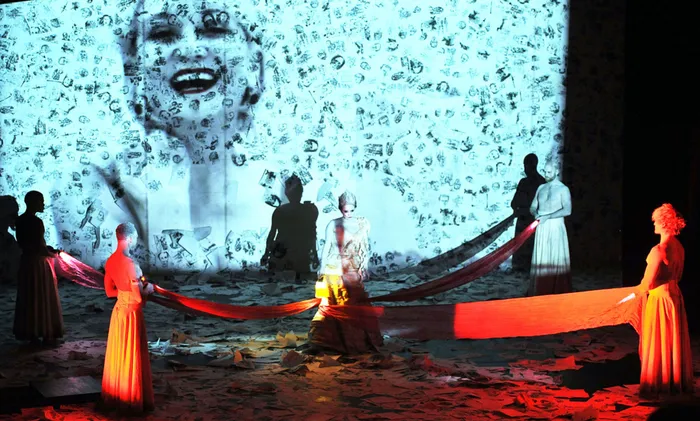'Les Cenci' haunting assault on the senses

Les Cenci an intermedial performance that explores mental illness, violence and theatrical cruelty through a semi-biographical dramatisation of the life of French poet, essayist, actor and theatre director, Antoine Marie Joseph Artaud, better known as Antonin Artaud.Through the combination of new media technology and the theoretical underpinnings of Artaud, the audience were taken on a horrific, and at times, light hearted journey inspired by his lifelong struggle with mental illness.022 Photo:Matthews Baloyi 01/07/2016 Les Cenci an intermedial performance that explores mental illness, violence and theatrical cruelty through a semi-biographical dramatisation of the life of French poet, essayist, actor and theatre director, Antoine Marie Joseph Artaud, better known as Antonin Artaud.Through the combination of new media technology and the theoretical underpinnings of Artaud, the audience were taken on a horrific, and at times, light hearted journey inspired by his lifelong struggle with mental illness.022 Photo:Matthews Baloyi 01/07/2016
GRAHAMSTOWN: Everything about Les Cenci screams madness.
The entire National Arts Festival production, by director Gopala Davies, is an assault on the senses from the moment one enters the theatre to the moment the play ends.
Pieces of white paper, covered in pen sketches spill out of the doors of the Victoria Theatre, and upon entering the venue you discover the entire floor, stage and stage backdrop are completely covered by these drawings.
Almost no stage lights are used throughout the performance and the predominant lighting comes from digital images and videos projected frequently onto the back wall.
The four men on stage appear ghostlike, wearing only long white skirts, the rest of their exposed bodies painted white. Each man has one glowing red light attached somewhere on his body. They use torches to light up their faces and various parts of their bodies as they writhe around on stage as recorded footage of them is shown simultaneously.
Erratic, flashing lighting coupled with unexpected, fright-inducing moments of loud static noise, with the accompanying visual on the screen, are enough to put any theatregoer on edge.
The experience is not meant to be a comfortable one.
The play is a semi-biographical dramatisation of the life of French poet, essayist, actor and theatre director Antonin Artaud, and as one of the performers points out in a digital recording, is an example of Theatre of Cruelty.
This concept, founded by Artaud, is meant to break from traditional Western theatre, move away from text-driven performances and shock the audience's senses.
The play explores mental illness and violence, and dips into Artaud’s suffering. He was diagnosed with spinal meningitis as a four-year-old and spent a great deal of his life in asylums.
The projected recordings, which are strangely humorous at times, explain how the man was molested by his father, battled with an opium addiction and was subjected to electroshock therapy while institutionalised.
After a five-minute-long monologue by one of the men, recorded footage of the same actor speaks back to him.
“Look at them. They’re bored… You’re boring. They don’t understand,” it says, eliciting sheepish sighs of relief from uncomfortable audience members.
Artaud’s madness is compounded when the faces on the screen multiply, laughing manically at him and are soon joined by the actors on stage, in one of the play’s many profoundly disturbing moments.
Towards the end of the production, a woman, also shrouded completely in white and carrying a lantern, who throughout the play moved from one side of the floor in front of the stage to the other, joins the four men on stage.
Presumably, she represents Beatrice Cenci, on whom Artaud’s play Les Cenci was based, in which the torture she endured at the hands of her father, nobleman Francesco Cenci, and the family’s subsequent plot to have him murdered, was dramatised.
After a short, striking scene of moving around the female figure, using red ribbons pulled from her dress, the play ends, with the men collapsed around her feet, and each light slowly turned off.
The actors continue their break from Western theatre norms and don’t take a bow, holding their statuesque pose as the audience filters, stunned, out of the venue.